Management Accounting Report: Decision Making for Imda Tech (2024)
VerifiedAdded on 2020/01/07
|16
|4373
|144
Report
AI Summary
This report provides a comprehensive analysis of management accounting principles, focusing on their application within Imda Tech, a company specializing in chargers and electronic gadgets. The report delves into the meaning and importance of management accounting, differentiating it from financial accounting and emphasizing its role in strategic decision-making. It examines various management accounting systems, including cost accounting, inventory management, and job costing, and their practical applications. The core of the report analyzes costing methods, comparing absorption and marginal costing through detailed calculations and reconciliation statements. Furthermore, it explores different budgeting types, their advantages and disadvantages, and the budgetary process. The report also investigates pricing strategies and the balance scorecard approach, detailing its implementation and significance in addressing financial problems and enhancing financial governance. The report concludes by summarizing the key findings and highlighting the importance of these tools in driving success for Imda Tech. The report includes tables illustrating calculations for costing methods and a reconciliation statement, enhancing the understanding of the concepts discussed.
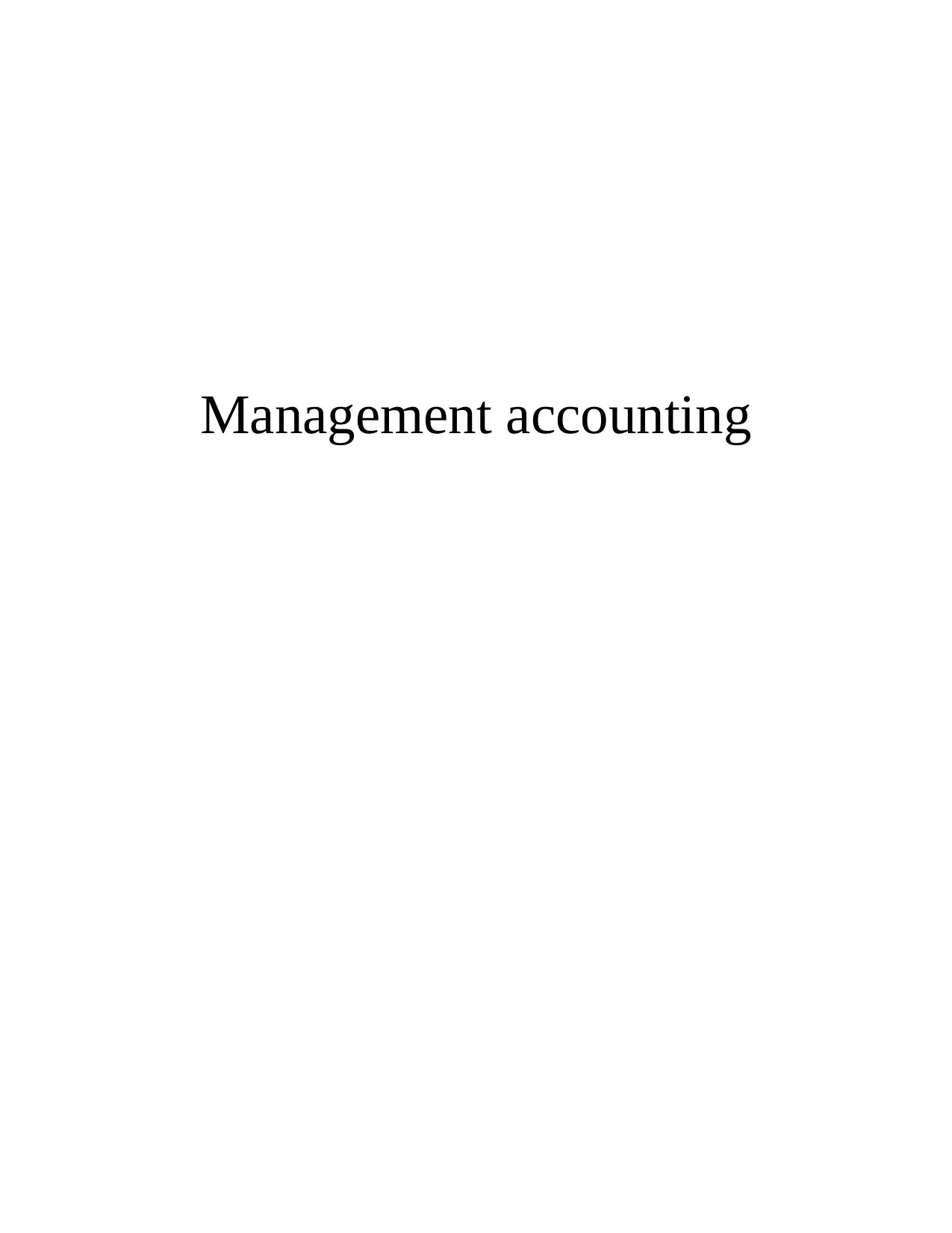
Management accounting
Paraphrase This Document
Need a fresh take? Get an instant paraphrase of this document with our AI Paraphraser
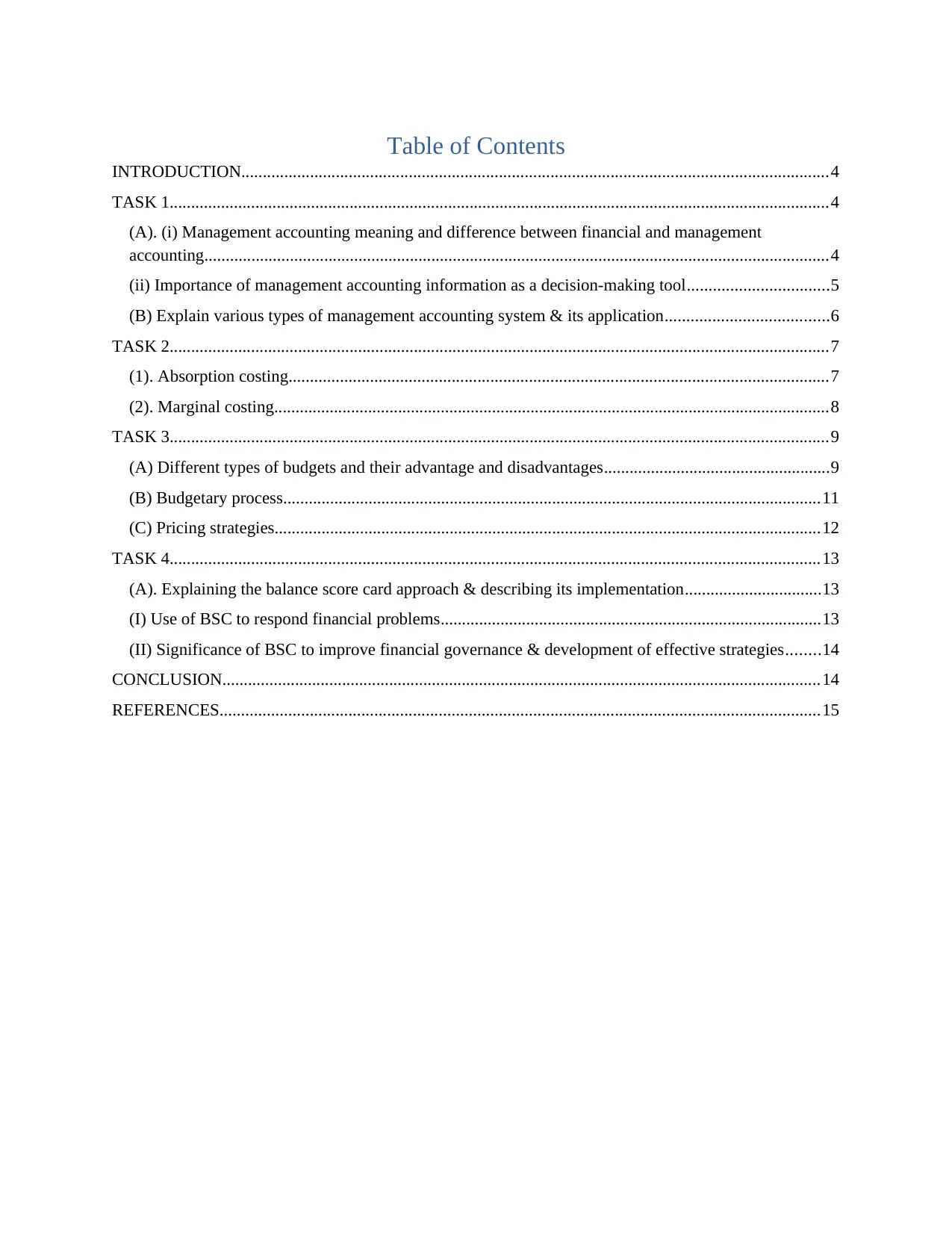
Table of Contents
INTRODUCTION.........................................................................................................................................4
TASK 1..........................................................................................................................................................4
(A). (i) Management accounting meaning and difference between financial and management
accounting..................................................................................................................................................4
(ii) Importance of management accounting information as a decision-making tool.................................5
(B) Explain various types of management accounting system & its application......................................6
TASK 2..........................................................................................................................................................7
(1). Absorption costing..............................................................................................................................7
(2). Marginal costing..................................................................................................................................8
TASK 3..........................................................................................................................................................9
(A) Different types of budgets and their advantage and disadvantages.....................................................9
(B) Budgetary process..............................................................................................................................11
(C) Pricing strategies................................................................................................................................12
TASK 4........................................................................................................................................................13
(A). Explaining the balance score card approach & describing its implementation................................13
(I) Use of BSC to respond financial problems.........................................................................................13
(II) Significance of BSC to improve financial governance & development of effective strategies........14
CONCLUSION............................................................................................................................................14
REFERENCES............................................................................................................................................15
INTRODUCTION.........................................................................................................................................4
TASK 1..........................................................................................................................................................4
(A). (i) Management accounting meaning and difference between financial and management
accounting..................................................................................................................................................4
(ii) Importance of management accounting information as a decision-making tool.................................5
(B) Explain various types of management accounting system & its application......................................6
TASK 2..........................................................................................................................................................7
(1). Absorption costing..............................................................................................................................7
(2). Marginal costing..................................................................................................................................8
TASK 3..........................................................................................................................................................9
(A) Different types of budgets and their advantage and disadvantages.....................................................9
(B) Budgetary process..............................................................................................................................11
(C) Pricing strategies................................................................................................................................12
TASK 4........................................................................................................................................................13
(A). Explaining the balance score card approach & describing its implementation................................13
(I) Use of BSC to respond financial problems.........................................................................................13
(II) Significance of BSC to improve financial governance & development of effective strategies........14
CONCLUSION............................................................................................................................................14
REFERENCES............................................................................................................................................15
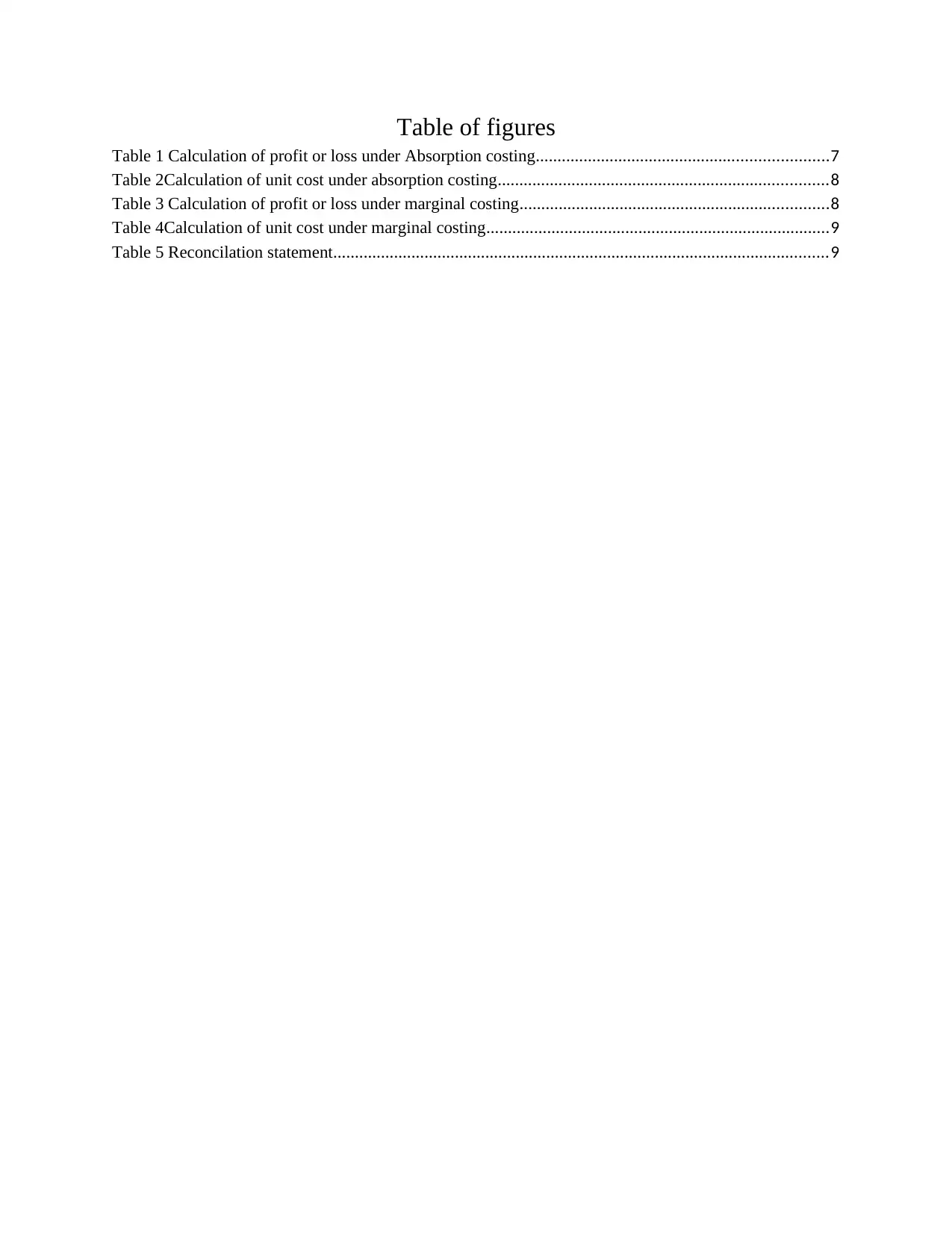
Table of figures
Table 1 Calculation of profit or loss under Absorption costing...................................................................7
Table 2Calculation of unit cost under absorption costing............................................................................8
Table 3 Calculation of profit or loss under marginal costing.......................................................................8
Table 4Calculation of unit cost under marginal costing...............................................................................9
Table 5 Reconcilation statement..................................................................................................................9
Table 1 Calculation of profit or loss under Absorption costing...................................................................7
Table 2Calculation of unit cost under absorption costing............................................................................8
Table 3 Calculation of profit or loss under marginal costing.......................................................................8
Table 4Calculation of unit cost under marginal costing...............................................................................9
Table 5 Reconcilation statement..................................................................................................................9
⊘ This is a preview!⊘
Do you want full access?
Subscribe today to unlock all pages.

Trusted by 1+ million students worldwide
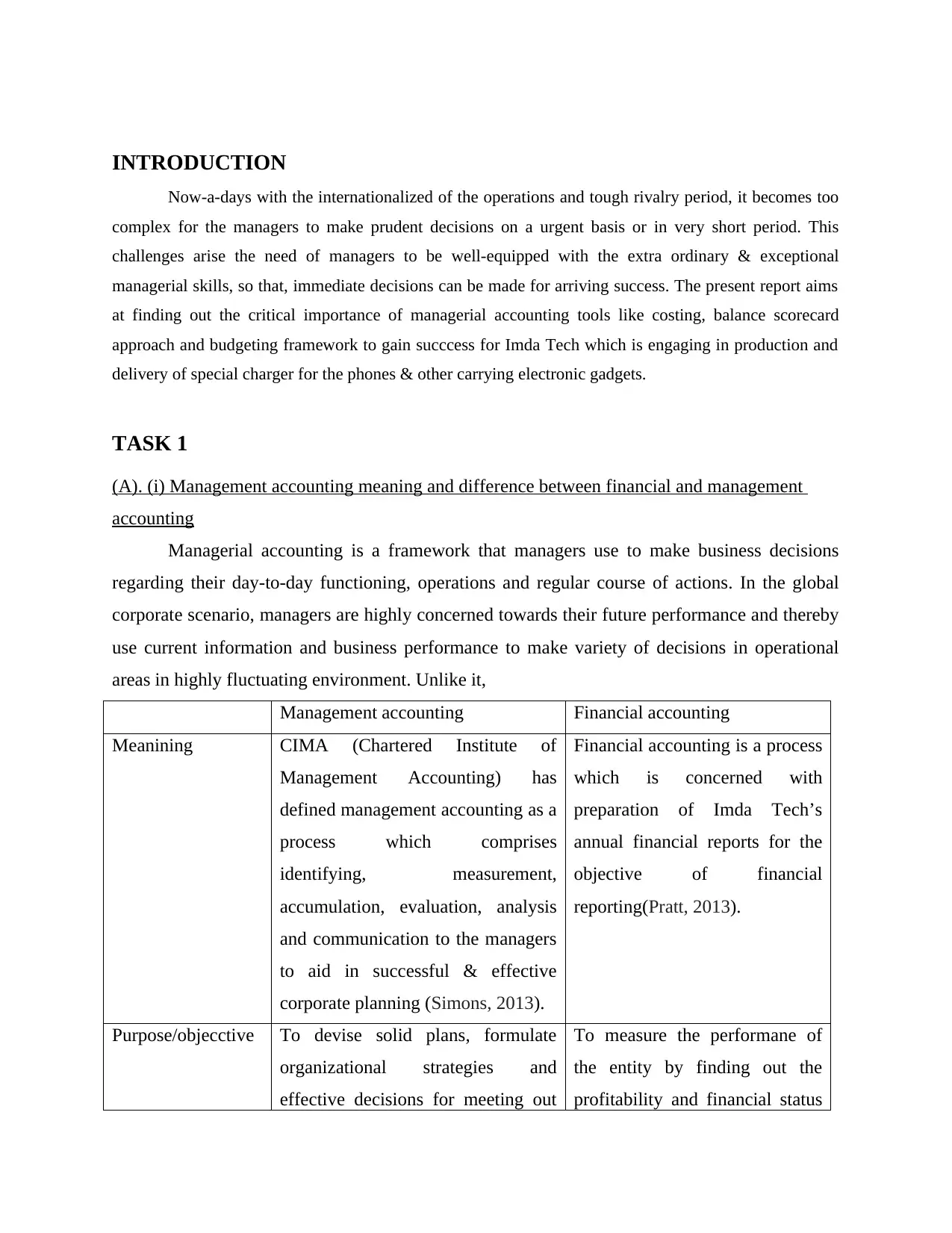
INTRODUCTION
Now-a-days with the internationalized of the operations and tough rivalry period, it becomes too
complex for the managers to make prudent decisions on a urgent basis or in very short period. This
challenges arise the need of managers to be well-equipped with the extra ordinary & exceptional
managerial skills, so that, immediate decisions can be made for arriving success. The present report aims
at finding out the critical importance of managerial accounting tools like costing, balance scorecard
approach and budgeting framework to gain succcess for Imda Tech which is engaging in production and
delivery of special charger for the phones & other carrying electronic gadgets.
TASK 1
(A). (i) Management accounting meaning and difference between financial and management
accounting
Managerial accounting is a framework that managers use to make business decisions
regarding their day-to-day functioning, operations and regular course of actions. In the global
corporate scenario, managers are highly concerned towards their future performance and thereby
use current information and business performance to make variety of decisions in operational
areas in highly fluctuating environment. Unlike it,
Management accounting Financial accounting
Meanining CIMA (Chartered Institute of
Management Accounting) has
defined management accounting as a
process which comprises
identifying, measurement,
accumulation, evaluation, analysis
and communication to the managers
to aid in successful & effective
corporate planning (Simons, 2013).
Financial accounting is a process
which is concerned with
preparation of Imda Tech’s
annual financial reports for the
objective of financial
reporting(Pratt, 2013).
Purpose/objecctive To devise solid plans, formulate
organizational strategies and
effective decisions for meeting out
To measure the performane of
the entity by finding out the
profitability and financial status
Now-a-days with the internationalized of the operations and tough rivalry period, it becomes too
complex for the managers to make prudent decisions on a urgent basis or in very short period. This
challenges arise the need of managers to be well-equipped with the extra ordinary & exceptional
managerial skills, so that, immediate decisions can be made for arriving success. The present report aims
at finding out the critical importance of managerial accounting tools like costing, balance scorecard
approach and budgeting framework to gain succcess for Imda Tech which is engaging in production and
delivery of special charger for the phones & other carrying electronic gadgets.
TASK 1
(A). (i) Management accounting meaning and difference between financial and management
accounting
Managerial accounting is a framework that managers use to make business decisions
regarding their day-to-day functioning, operations and regular course of actions. In the global
corporate scenario, managers are highly concerned towards their future performance and thereby
use current information and business performance to make variety of decisions in operational
areas in highly fluctuating environment. Unlike it,
Management accounting Financial accounting
Meanining CIMA (Chartered Institute of
Management Accounting) has
defined management accounting as a
process which comprises
identifying, measurement,
accumulation, evaluation, analysis
and communication to the managers
to aid in successful & effective
corporate planning (Simons, 2013).
Financial accounting is a process
which is concerned with
preparation of Imda Tech’s
annual financial reports for the
objective of financial
reporting(Pratt, 2013).
Purpose/objecctive To devise solid plans, formulate
organizational strategies and
effective decisions for meeting out
To measure the performane of
the entity by finding out the
profitability and financial status
Paraphrase This Document
Need a fresh take? Get an instant paraphrase of this document with our AI Paraphraser
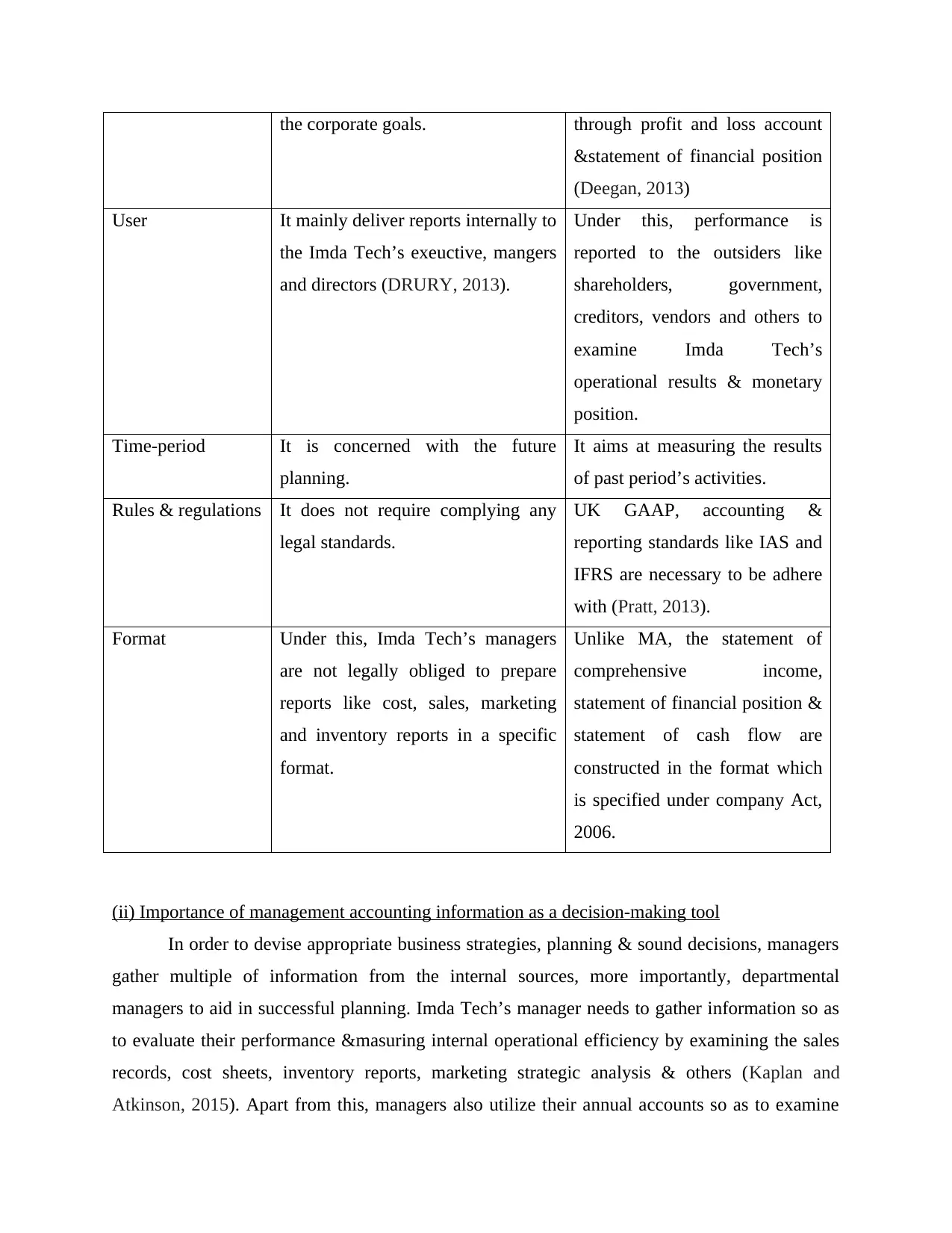
the corporate goals. through profit and loss account
&statement of financial position
(Deegan, 2013)
User It mainly deliver reports internally to
the Imda Tech’s exeuctive, mangers
and directors (DRURY, 2013).
Under this, performance is
reported to the outsiders like
shareholders, government,
creditors, vendors and others to
examine Imda Tech’s
operational results & monetary
position.
Time-period It is concerned with the future
planning.
It aims at measuring the results
of past period’s activities.
Rules & regulations It does not require complying any
legal standards.
UK GAAP, accounting &
reporting standards like IAS and
IFRS are necessary to be adhere
with (Pratt, 2013).
Format Under this, Imda Tech’s managers
are not legally obliged to prepare
reports like cost, sales, marketing
and inventory reports in a specific
format.
Unlike MA, the statement of
comprehensive income,
statement of financial position &
statement of cash flow are
constructed in the format which
is specified under company Act,
2006.
(ii) Importance of management accounting information as a decision-making tool
In order to devise appropriate business strategies, planning & sound decisions, managers
gather multiple of information from the internal sources, more importantly, departmental
managers to aid in successful planning. Imda Tech’s manager needs to gather information so as
to evaluate their performance &masuring internal operational efficiency by examining the sales
records, cost sheets, inventory reports, marketing strategic analysis & others (Kaplan and
Atkinson, 2015). Apart from this, managers also utilize their annual accounts so as to examine
&statement of financial position
(Deegan, 2013)
User It mainly deliver reports internally to
the Imda Tech’s exeuctive, mangers
and directors (DRURY, 2013).
Under this, performance is
reported to the outsiders like
shareholders, government,
creditors, vendors and others to
examine Imda Tech’s
operational results & monetary
position.
Time-period It is concerned with the future
planning.
It aims at measuring the results
of past period’s activities.
Rules & regulations It does not require complying any
legal standards.
UK GAAP, accounting &
reporting standards like IAS and
IFRS are necessary to be adhere
with (Pratt, 2013).
Format Under this, Imda Tech’s managers
are not legally obliged to prepare
reports like cost, sales, marketing
and inventory reports in a specific
format.
Unlike MA, the statement of
comprehensive income,
statement of financial position &
statement of cash flow are
constructed in the format which
is specified under company Act,
2006.
(ii) Importance of management accounting information as a decision-making tool
In order to devise appropriate business strategies, planning & sound decisions, managers
gather multiple of information from the internal sources, more importantly, departmental
managers to aid in successful planning. Imda Tech’s manager needs to gather information so as
to evaluate their performance &masuring internal operational efficiency by examining the sales
records, cost sheets, inventory reports, marketing strategic analysis & others (Kaplan and
Atkinson, 2015). Apart from this, managers also utilize their annual accounts so as to examine
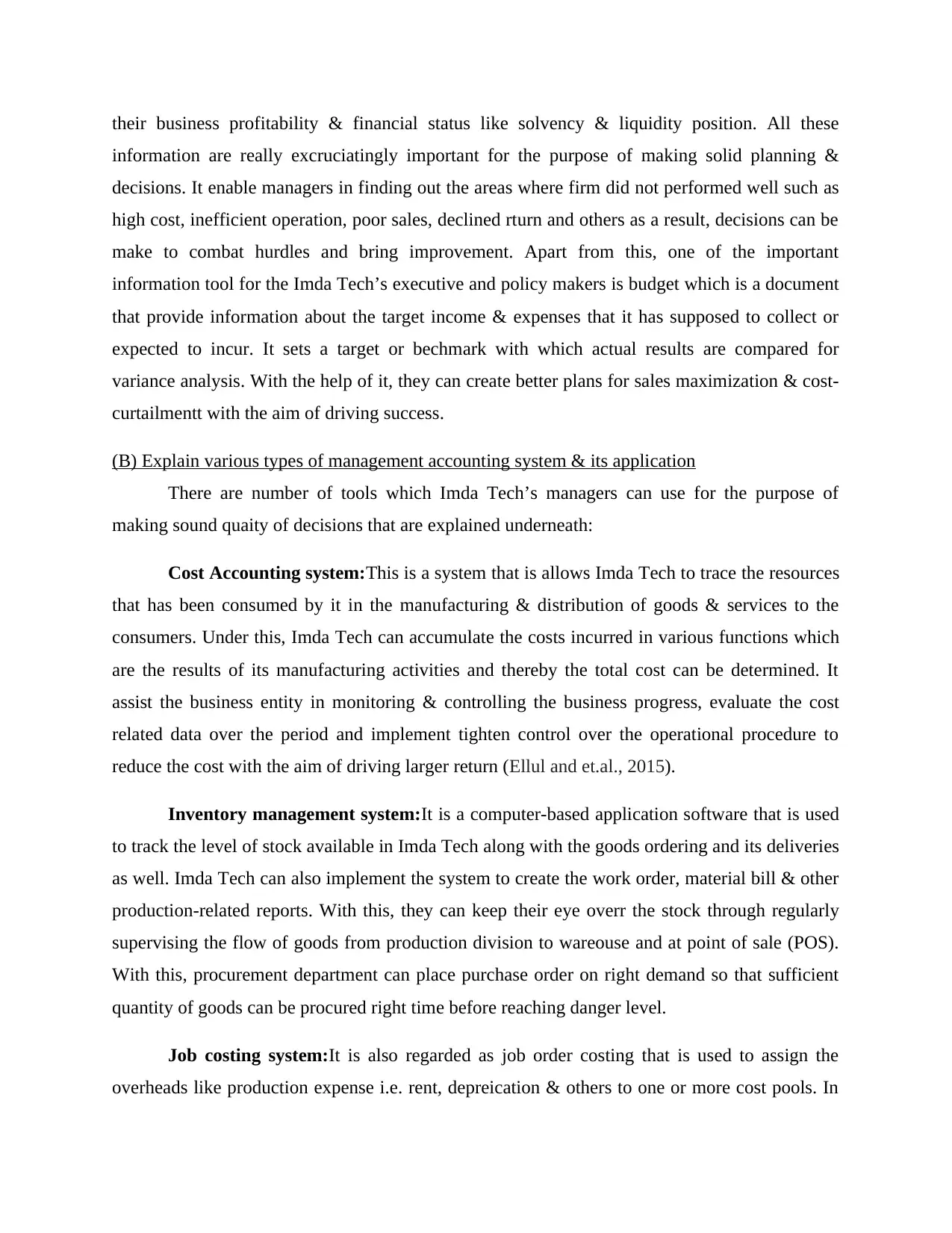
their business profitability & financial status like solvency & liquidity position. All these
information are really excruciatingly important for the purpose of making solid planning &
decisions. It enable managers in finding out the areas where firm did not performed well such as
high cost, inefficient operation, poor sales, declined rturn and others as a result, decisions can be
make to combat hurdles and bring improvement. Apart from this, one of the important
information tool for the Imda Tech’s executive and policy makers is budget which is a document
that provide information about the target income & expenses that it has supposed to collect or
expected to incur. It sets a target or bechmark with which actual results are compared for
variance analysis. With the help of it, they can create better plans for sales maximization & cost-
curtailmentt with the aim of driving success.
(B) Explain various types of management accounting system & its application
There are number of tools which Imda Tech’s managers can use for the purpose of
making sound quaity of decisions that are explained underneath:
Cost Accounting system:This is a system that is allows Imda Tech to trace the resources
that has been consumed by it in the manufacturing & distribution of goods & services to the
consumers. Under this, Imda Tech can accumulate the costs incurred in various functions which
are the results of its manufacturing activities and thereby the total cost can be determined. It
assist the business entity in monitoring & controlling the business progress, evaluate the cost
related data over the period and implement tighten control over the operational procedure to
reduce the cost with the aim of driving larger return (Ellul and et.al., 2015).
Inventory management system:It is a computer-based application software that is used
to track the level of stock available in Imda Tech along with the goods ordering and its deliveries
as well. Imda Tech can also implement the system to create the work order, material bill & other
production-related reports. With this, they can keep their eye overr the stock through regularly
supervising the flow of goods from production division to wareouse and at point of sale (POS).
With this, procurement department can place purchase order on right demand so that sufficient
quantity of goods can be procured right time before reaching danger level.
Job costing system:It is also regarded as job order costing that is used to assign the
overheads like production expense i.e. rent, depreication & others to one or more cost pools. In
information are really excruciatingly important for the purpose of making solid planning &
decisions. It enable managers in finding out the areas where firm did not performed well such as
high cost, inefficient operation, poor sales, declined rturn and others as a result, decisions can be
make to combat hurdles and bring improvement. Apart from this, one of the important
information tool for the Imda Tech’s executive and policy makers is budget which is a document
that provide information about the target income & expenses that it has supposed to collect or
expected to incur. It sets a target or bechmark with which actual results are compared for
variance analysis. With the help of it, they can create better plans for sales maximization & cost-
curtailmentt with the aim of driving success.
(B) Explain various types of management accounting system & its application
There are number of tools which Imda Tech’s managers can use for the purpose of
making sound quaity of decisions that are explained underneath:
Cost Accounting system:This is a system that is allows Imda Tech to trace the resources
that has been consumed by it in the manufacturing & distribution of goods & services to the
consumers. Under this, Imda Tech can accumulate the costs incurred in various functions which
are the results of its manufacturing activities and thereby the total cost can be determined. It
assist the business entity in monitoring & controlling the business progress, evaluate the cost
related data over the period and implement tighten control over the operational procedure to
reduce the cost with the aim of driving larger return (Ellul and et.al., 2015).
Inventory management system:It is a computer-based application software that is used
to track the level of stock available in Imda Tech along with the goods ordering and its deliveries
as well. Imda Tech can also implement the system to create the work order, material bill & other
production-related reports. With this, they can keep their eye overr the stock through regularly
supervising the flow of goods from production division to wareouse and at point of sale (POS).
With this, procurement department can place purchase order on right demand so that sufficient
quantity of goods can be procured right time before reaching danger level.
Job costing system:It is also regarded as job order costing that is used to assign the
overheads like production expense i.e. rent, depreication & others to one or more cost pools. In
⊘ This is a preview!⊘
Do you want full access?
Subscribe today to unlock all pages.

Trusted by 1+ million students worldwide
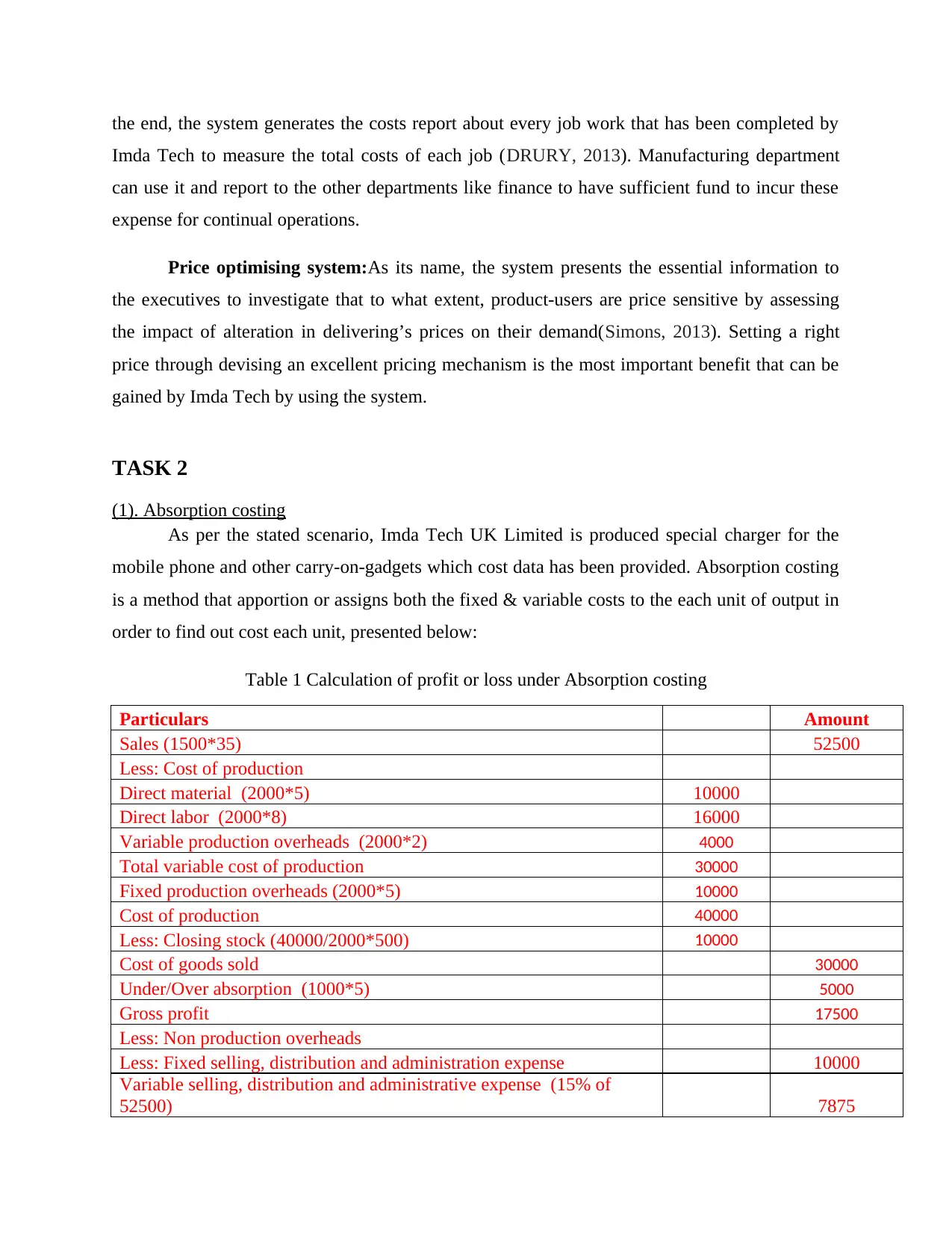
the end, the system generates the costs report about every job work that has been completed by
Imda Tech to measure the total costs of each job (DRURY, 2013). Manufacturing department
can use it and report to the other departments like finance to have sufficient fund to incur these
expense for continual operations.
Price optimising system:As its name, the system presents the essential information to
the executives to investigate that to what extent, product-users are price sensitive by assessing
the impact of alteration in delivering’s prices on their demand(Simons, 2013). Setting a right
price through devising an excellent pricing mechanism is the most important benefit that can be
gained by Imda Tech by using the system.
TASK 2
(1). Absorption costing
As per the stated scenario, Imda Tech UK Limited is produced special charger for the
mobile phone and other carry-on-gadgets which cost data has been provided. Absorption costing
is a method that apportion or assigns both the fixed & variable costs to the each unit of output in
order to find out cost each unit, presented below:
Table 1 Calculation of profit or loss under Absorption costing
Particulars Amount
Sales (1500*35) 52500
Less: Cost of production
Direct material (2000*5) 10000
Direct labor (2000*8) 16000
Variable production overheads (2000*2) 4000
Total variable cost of production 30000
Fixed production overheads (2000*5) 10000
Cost of production 40000
Less: Closing stock (40000/2000*500) 10000
Cost of goods sold 30000
Under/Over absorption (1000*5) 5000
Gross profit 17500
Less: Non production overheads
Less: Fixed selling, distribution and administration expense 10000
Variable selling, distribution and administrative expense (15% of
52500) 7875
Imda Tech to measure the total costs of each job (DRURY, 2013). Manufacturing department
can use it and report to the other departments like finance to have sufficient fund to incur these
expense for continual operations.
Price optimising system:As its name, the system presents the essential information to
the executives to investigate that to what extent, product-users are price sensitive by assessing
the impact of alteration in delivering’s prices on their demand(Simons, 2013). Setting a right
price through devising an excellent pricing mechanism is the most important benefit that can be
gained by Imda Tech by using the system.
TASK 2
(1). Absorption costing
As per the stated scenario, Imda Tech UK Limited is produced special charger for the
mobile phone and other carry-on-gadgets which cost data has been provided. Absorption costing
is a method that apportion or assigns both the fixed & variable costs to the each unit of output in
order to find out cost each unit, presented below:
Table 1 Calculation of profit or loss under Absorption costing
Particulars Amount
Sales (1500*35) 52500
Less: Cost of production
Direct material (2000*5) 10000
Direct labor (2000*8) 16000
Variable production overheads (2000*2) 4000
Total variable cost of production 30000
Fixed production overheads (2000*5) 10000
Cost of production 40000
Less: Closing stock (40000/2000*500) 10000
Cost of goods sold 30000
Under/Over absorption (1000*5) 5000
Gross profit 17500
Less: Non production overheads
Less: Fixed selling, distribution and administration expense 10000
Variable selling, distribution and administrative expense (15% of
52500) 7875
Paraphrase This Document
Need a fresh take? Get an instant paraphrase of this document with our AI Paraphraser
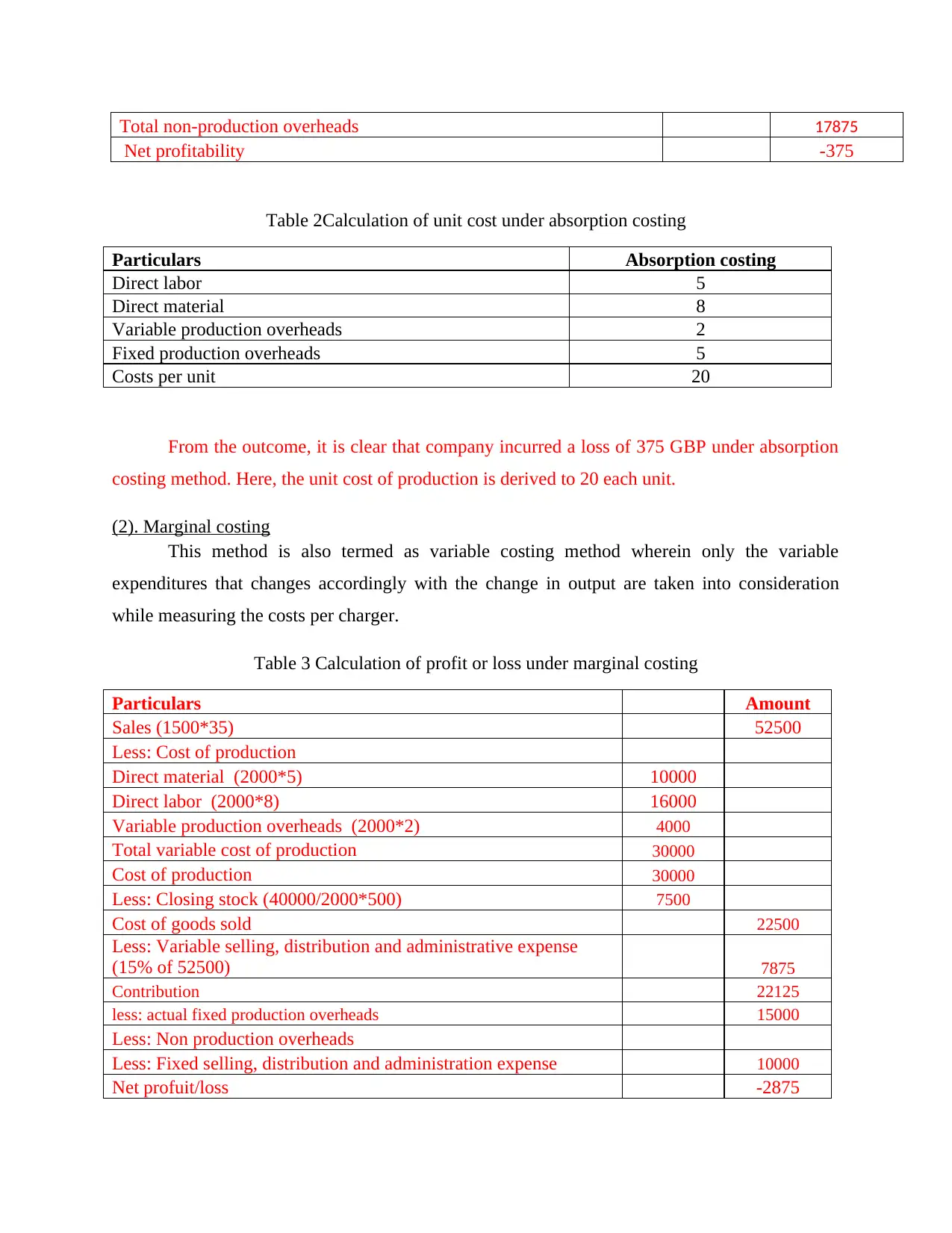
Total non-production overheads 17875
Net profitability -375
Table 2Calculation of unit cost under absorption costing
Particulars Absorption costing
Direct labor 5
Direct material 8
Variable production overheads 2
Fixed production overheads 5
Costs per unit 20
From the outcome, it is clear that company incurred a loss of 375 GBP under absorption
costing method. Here, the unit cost of production is derived to 20 each unit.
(2). Marginal costing
This method is also termed as variable costing method wherein only the variable
expenditures that changes accordingly with the change in output are taken into consideration
while measuring the costs per charger.
Table 3 Calculation of profit or loss under marginal costing
Particulars Amount
Sales (1500*35) 52500
Less: Cost of production
Direct material (2000*5) 10000
Direct labor (2000*8) 16000
Variable production overheads (2000*2) 4000
Total variable cost of production 30000
Cost of production 30000
Less: Closing stock (40000/2000*500) 7500
Cost of goods sold 22500
Less: Variable selling, distribution and administrative expense
(15% of 52500) 7875
Contribution 22125
less: actual fixed production overheads 15000
Less: Non production overheads
Less: Fixed selling, distribution and administration expense 10000
Net profuit/loss -2875
Net profitability -375
Table 2Calculation of unit cost under absorption costing
Particulars Absorption costing
Direct labor 5
Direct material 8
Variable production overheads 2
Fixed production overheads 5
Costs per unit 20
From the outcome, it is clear that company incurred a loss of 375 GBP under absorption
costing method. Here, the unit cost of production is derived to 20 each unit.
(2). Marginal costing
This method is also termed as variable costing method wherein only the variable
expenditures that changes accordingly with the change in output are taken into consideration
while measuring the costs per charger.
Table 3 Calculation of profit or loss under marginal costing
Particulars Amount
Sales (1500*35) 52500
Less: Cost of production
Direct material (2000*5) 10000
Direct labor (2000*8) 16000
Variable production overheads (2000*2) 4000
Total variable cost of production 30000
Cost of production 30000
Less: Closing stock (40000/2000*500) 7500
Cost of goods sold 22500
Less: Variable selling, distribution and administrative expense
(15% of 52500) 7875
Contribution 22125
less: actual fixed production overheads 15000
Less: Non production overheads
Less: Fixed selling, distribution and administration expense 10000
Net profuit/loss -2875
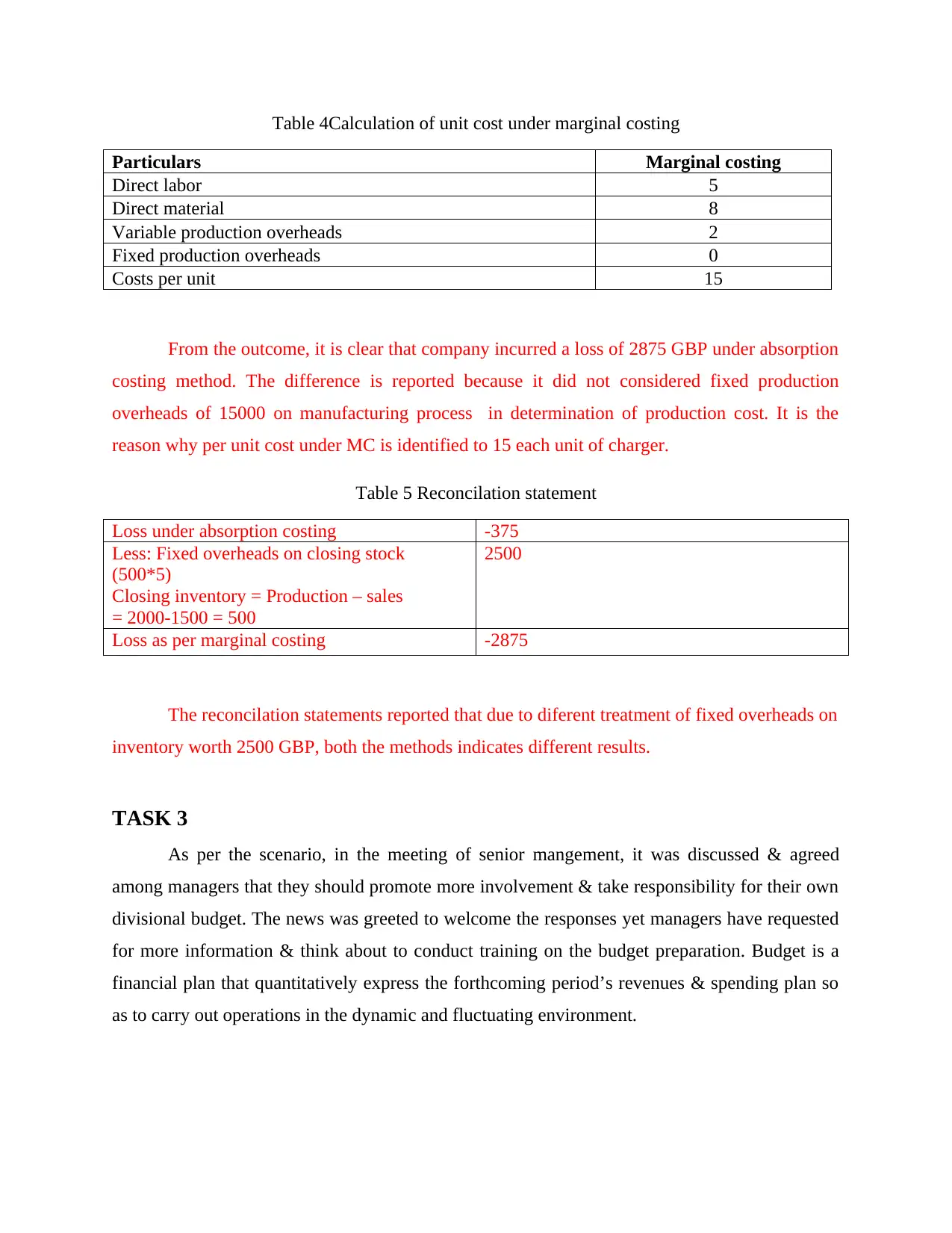
Table 4Calculation of unit cost under marginal costing
Particulars Marginal costing
Direct labor 5
Direct material 8
Variable production overheads 2
Fixed production overheads 0
Costs per unit 15
From the outcome, it is clear that company incurred a loss of 2875 GBP under absorption
costing method. The difference is reported because it did not considered fixed production
overheads of 15000 on manufacturing process in determination of production cost. It is the
reason why per unit cost under MC is identified to 15 each unit of charger.
Table 5 Reconcilation statement
Loss under absorption costing -375
Less: Fixed overheads on closing stock
(500*5)
Closing inventory = Production – sales
= 2000-1500 = 500
2500
Loss as per marginal costing -2875
The reconcilation statements reported that due to diferent treatment of fixed overheads on
inventory worth 2500 GBP, both the methods indicates different results.
TASK 3
As per the scenario, in the meeting of senior mangement, it was discussed & agreed
among managers that they should promote more involvement & take responsibility for their own
divisional budget. The news was greeted to welcome the responses yet managers have requested
for more information & think about to conduct training on the budget preparation. Budget is a
financial plan that quantitatively express the forthcoming period’s revenues & spending plan so
as to carry out operations in the dynamic and fluctuating environment.
Particulars Marginal costing
Direct labor 5
Direct material 8
Variable production overheads 2
Fixed production overheads 0
Costs per unit 15
From the outcome, it is clear that company incurred a loss of 2875 GBP under absorption
costing method. The difference is reported because it did not considered fixed production
overheads of 15000 on manufacturing process in determination of production cost. It is the
reason why per unit cost under MC is identified to 15 each unit of charger.
Table 5 Reconcilation statement
Loss under absorption costing -375
Less: Fixed overheads on closing stock
(500*5)
Closing inventory = Production – sales
= 2000-1500 = 500
2500
Loss as per marginal costing -2875
The reconcilation statements reported that due to diferent treatment of fixed overheads on
inventory worth 2500 GBP, both the methods indicates different results.
TASK 3
As per the scenario, in the meeting of senior mangement, it was discussed & agreed
among managers that they should promote more involvement & take responsibility for their own
divisional budget. The news was greeted to welcome the responses yet managers have requested
for more information & think about to conduct training on the budget preparation. Budget is a
financial plan that quantitatively express the forthcoming period’s revenues & spending plan so
as to carry out operations in the dynamic and fluctuating environment.
⊘ This is a preview!⊘
Do you want full access?
Subscribe today to unlock all pages.

Trusted by 1+ million students worldwide
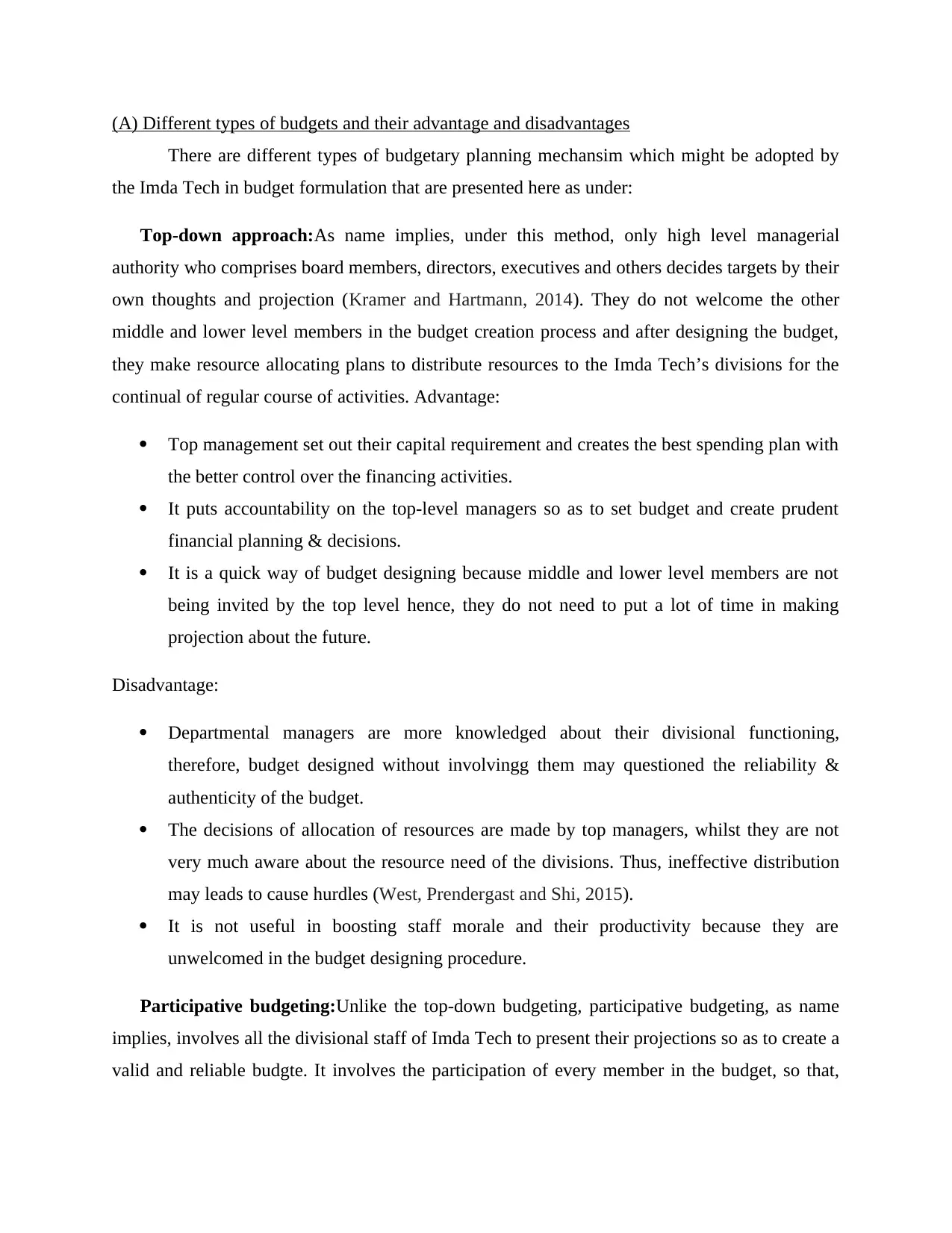
(A) Different types of budgets and their advantage and disadvantages
There are different types of budgetary planning mechansim which might be adopted by
the Imda Tech in budget formulation that are presented here as under:
Top-down approach:As name implies, under this method, only high level managerial
authority who comprises board members, directors, executives and others decides targets by their
own thoughts and projection (Kramer and Hartmann, 2014). They do not welcome the other
middle and lower level members in the budget creation process and after designing the budget,
they make resource allocating plans to distribute resources to the Imda Tech’s divisions for the
continual of regular course of activities. Advantage:
Top management set out their capital requirement and creates the best spending plan with
the better control over the financing activities.
It puts accountability on the top-level managers so as to set budget and create prudent
financial planning & decisions.
It is a quick way of budget designing because middle and lower level members are not
being invited by the top level hence, they do not need to put a lot of time in making
projection about the future.
Disadvantage:
Departmental managers are more knowledged about their divisional functioning,
therefore, budget designed without involvingg them may questioned the reliability &
authenticity of the budget.
The decisions of allocation of resources are made by top managers, whilst they are not
very much aware about the resource need of the divisions. Thus, ineffective distribution
may leads to cause hurdles (West, Prendergast and Shi, 2015).
It is not useful in boosting staff morale and their productivity because they are
unwelcomed in the budget designing procedure.
Participative budgeting:Unlike the top-down budgeting, participative budgeting, as name
implies, involves all the divisional staff of Imda Tech to present their projections so as to create a
valid and reliable budgte. It involves the participation of every member in the budget, so that,
There are different types of budgetary planning mechansim which might be adopted by
the Imda Tech in budget formulation that are presented here as under:
Top-down approach:As name implies, under this method, only high level managerial
authority who comprises board members, directors, executives and others decides targets by their
own thoughts and projection (Kramer and Hartmann, 2014). They do not welcome the other
middle and lower level members in the budget creation process and after designing the budget,
they make resource allocating plans to distribute resources to the Imda Tech’s divisions for the
continual of regular course of activities. Advantage:
Top management set out their capital requirement and creates the best spending plan with
the better control over the financing activities.
It puts accountability on the top-level managers so as to set budget and create prudent
financial planning & decisions.
It is a quick way of budget designing because middle and lower level members are not
being invited by the top level hence, they do not need to put a lot of time in making
projection about the future.
Disadvantage:
Departmental managers are more knowledged about their divisional functioning,
therefore, budget designed without involvingg them may questioned the reliability &
authenticity of the budget.
The decisions of allocation of resources are made by top managers, whilst they are not
very much aware about the resource need of the divisions. Thus, ineffective distribution
may leads to cause hurdles (West, Prendergast and Shi, 2015).
It is not useful in boosting staff morale and their productivity because they are
unwelcomed in the budget designing procedure.
Participative budgeting:Unlike the top-down budgeting, participative budgeting, as name
implies, involves all the divisional staff of Imda Tech to present their projections so as to create a
valid and reliable budgte. It involves the participation of every member in the budget, so that,
Paraphrase This Document
Need a fresh take? Get an instant paraphrase of this document with our AI Paraphraser
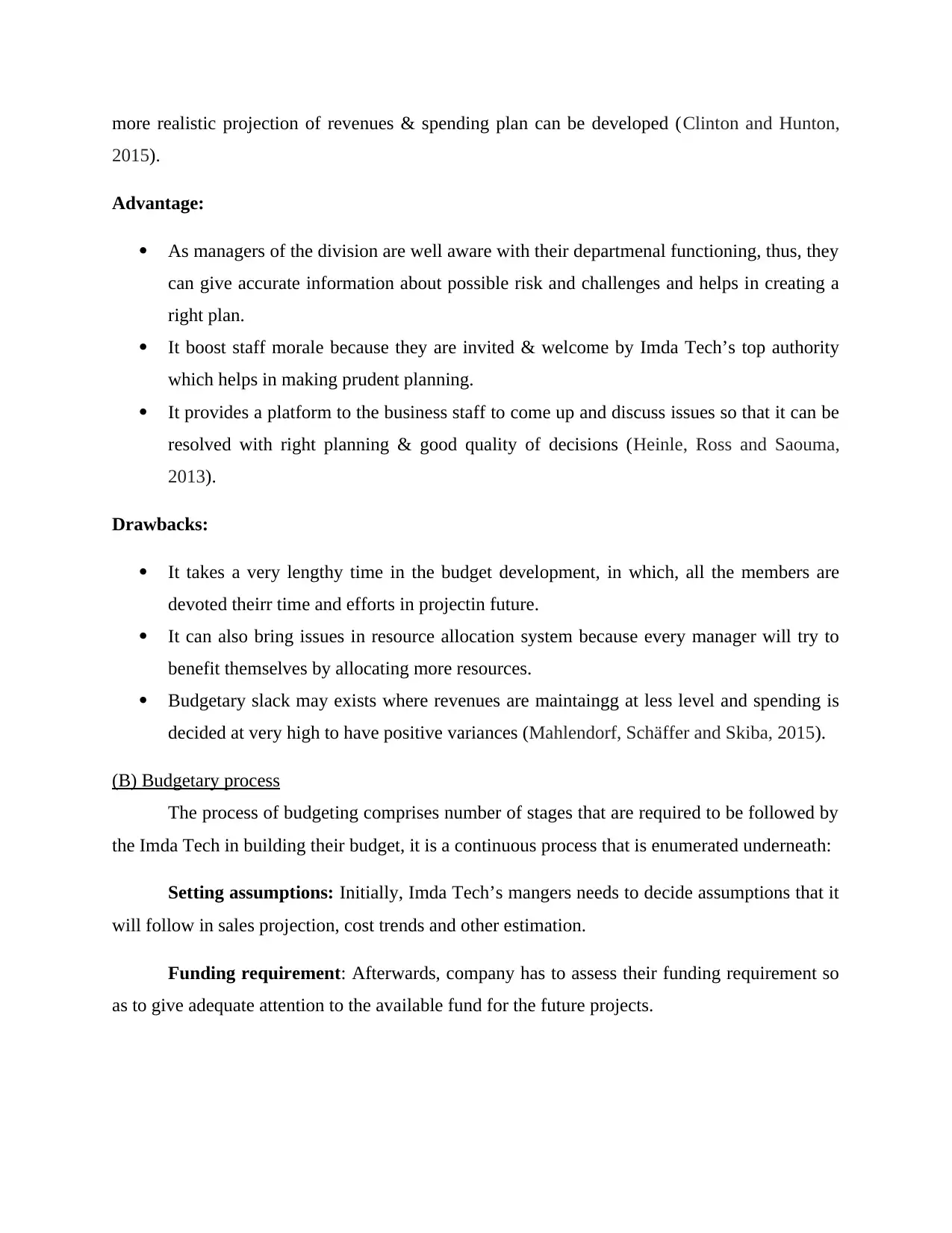
more realistic projection of revenues & spending plan can be developed (Clinton and Hunton,
2015).
Advantage:
As managers of the division are well aware with their departmenal functioning, thus, they
can give accurate information about possible risk and challenges and helps in creating a
right plan.
It boost staff morale because they are invited & welcome by Imda Tech’s top authority
which helps in making prudent planning.
It provides a platform to the business staff to come up and discuss issues so that it can be
resolved with right planning & good quality of decisions (Heinle, Ross and Saouma,
2013).
Drawbacks:
It takes a very lengthy time in the budget development, in which, all the members are
devoted theirr time and efforts in projectin future.
It can also bring issues in resource allocation system because every manager will try to
benefit themselves by allocating more resources.
Budgetary slack may exists where revenues are maintaingg at less level and spending is
decided at very high to have positive variances (Mahlendorf, Schäffer and Skiba, 2015).
(B) Budgetary process
The process of budgeting comprises number of stages that are required to be followed by
the Imda Tech in building their budget, it is a continuous process that is enumerated underneath:
Setting assumptions: Initially, Imda Tech’s mangers needs to decide assumptions that it
will follow in sales projection, cost trends and other estimation.
Funding requirement: Afterwards, company has to assess their funding requirement so
as to give adequate attention to the available fund for the future projects.
2015).
Advantage:
As managers of the division are well aware with their departmenal functioning, thus, they
can give accurate information about possible risk and challenges and helps in creating a
right plan.
It boost staff morale because they are invited & welcome by Imda Tech’s top authority
which helps in making prudent planning.
It provides a platform to the business staff to come up and discuss issues so that it can be
resolved with right planning & good quality of decisions (Heinle, Ross and Saouma,
2013).
Drawbacks:
It takes a very lengthy time in the budget development, in which, all the members are
devoted theirr time and efforts in projectin future.
It can also bring issues in resource allocation system because every manager will try to
benefit themselves by allocating more resources.
Budgetary slack may exists where revenues are maintaingg at less level and spending is
decided at very high to have positive variances (Mahlendorf, Schäffer and Skiba, 2015).
(B) Budgetary process
The process of budgeting comprises number of stages that are required to be followed by
the Imda Tech in building their budget, it is a continuous process that is enumerated underneath:
Setting assumptions: Initially, Imda Tech’s mangers needs to decide assumptions that it
will follow in sales projection, cost trends and other estimation.
Funding requirement: Afterwards, company has to assess their funding requirement so
as to give adequate attention to the available fund for the future projects.
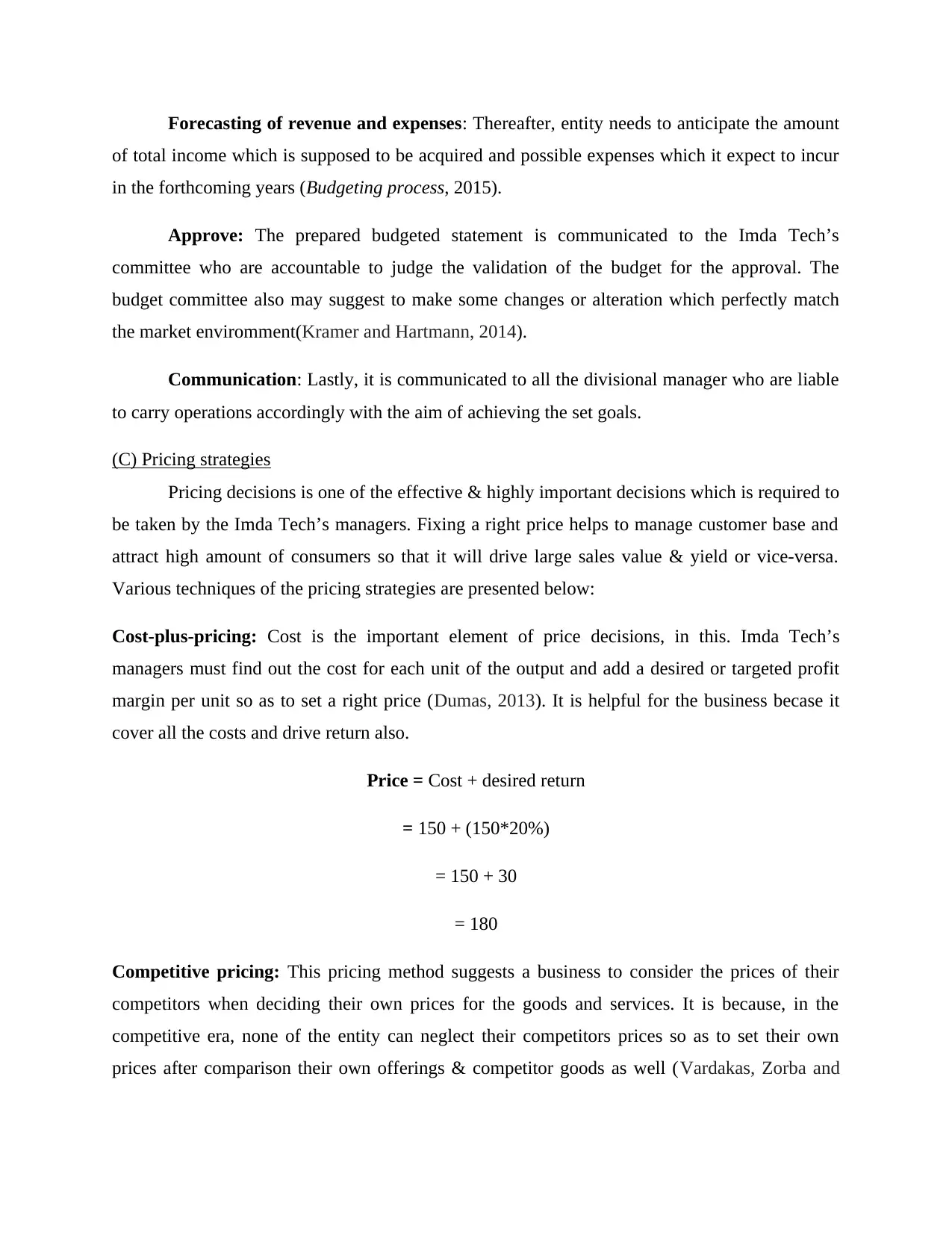
Forecasting of revenue and expenses: Thereafter, entity needs to anticipate the amount
of total income which is supposed to be acquired and possible expenses which it expect to incur
in the forthcoming years (Budgeting process, 2015).
Approve: The prepared budgeted statement is communicated to the Imda Tech’s
committee who are accountable to judge the validation of the budget for the approval. The
budget committee also may suggest to make some changes or alteration which perfectly match
the market enviromment(Kramer and Hartmann, 2014).
Communication: Lastly, it is communicated to all the divisional manager who are liable
to carry operations accordingly with the aim of achieving the set goals.
(C) Pricing strategies
Pricing decisions is one of the effective & highly important decisions which is required to
be taken by the Imda Tech’s managers. Fixing a right price helps to manage customer base and
attract high amount of consumers so that it will drive large sales value & yield or vice-versa.
Various techniques of the pricing strategies are presented below:
Cost-plus-pricing: Cost is the important element of price decisions, in this. Imda Tech’s
managers must find out the cost for each unit of the output and add a desired or targeted profit
margin per unit so as to set a right price (Dumas, 2013). It is helpful for the business becase it
cover all the costs and drive return also.
Price = Cost + desired return
= 150 + (150*20%)
= 150 + 30
= 180
Competitive pricing: This pricing method suggests a business to consider the prices of their
competitors when deciding their own prices for the goods and services. It is because, in the
competitive era, none of the entity can neglect their competitors prices so as to set their own
prices after comparison their own offerings & competitor goods as well (Vardakas, Zorba and
of total income which is supposed to be acquired and possible expenses which it expect to incur
in the forthcoming years (Budgeting process, 2015).
Approve: The prepared budgeted statement is communicated to the Imda Tech’s
committee who are accountable to judge the validation of the budget for the approval. The
budget committee also may suggest to make some changes or alteration which perfectly match
the market enviromment(Kramer and Hartmann, 2014).
Communication: Lastly, it is communicated to all the divisional manager who are liable
to carry operations accordingly with the aim of achieving the set goals.
(C) Pricing strategies
Pricing decisions is one of the effective & highly important decisions which is required to
be taken by the Imda Tech’s managers. Fixing a right price helps to manage customer base and
attract high amount of consumers so that it will drive large sales value & yield or vice-versa.
Various techniques of the pricing strategies are presented below:
Cost-plus-pricing: Cost is the important element of price decisions, in this. Imda Tech’s
managers must find out the cost for each unit of the output and add a desired or targeted profit
margin per unit so as to set a right price (Dumas, 2013). It is helpful for the business becase it
cover all the costs and drive return also.
Price = Cost + desired return
= 150 + (150*20%)
= 150 + 30
= 180
Competitive pricing: This pricing method suggests a business to consider the prices of their
competitors when deciding their own prices for the goods and services. It is because, in the
competitive era, none of the entity can neglect their competitors prices so as to set their own
prices after comparison their own offerings & competitor goods as well (Vardakas, Zorba and
⊘ This is a preview!⊘
Do you want full access?
Subscribe today to unlock all pages.

Trusted by 1+ million students worldwide
1 out of 16
Related Documents
Your All-in-One AI-Powered Toolkit for Academic Success.
+13062052269
info@desklib.com
Available 24*7 on WhatsApp / Email
![[object Object]](/_next/static/media/star-bottom.7253800d.svg)
Unlock your academic potential
Copyright © 2020–2025 A2Z Services. All Rights Reserved. Developed and managed by ZUCOL.





